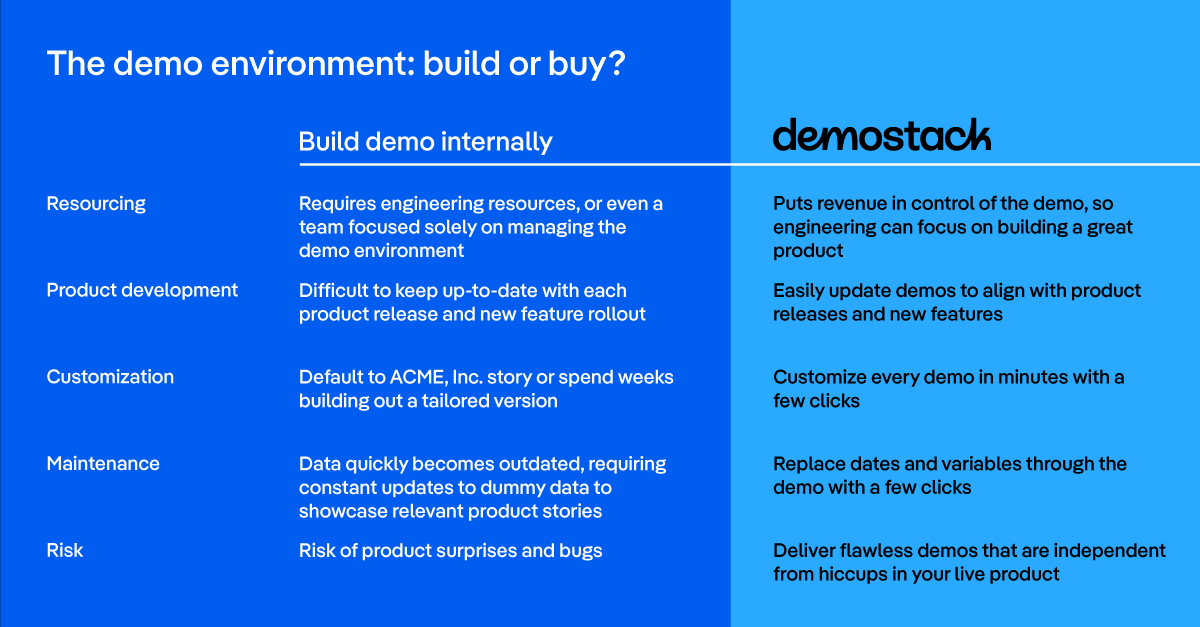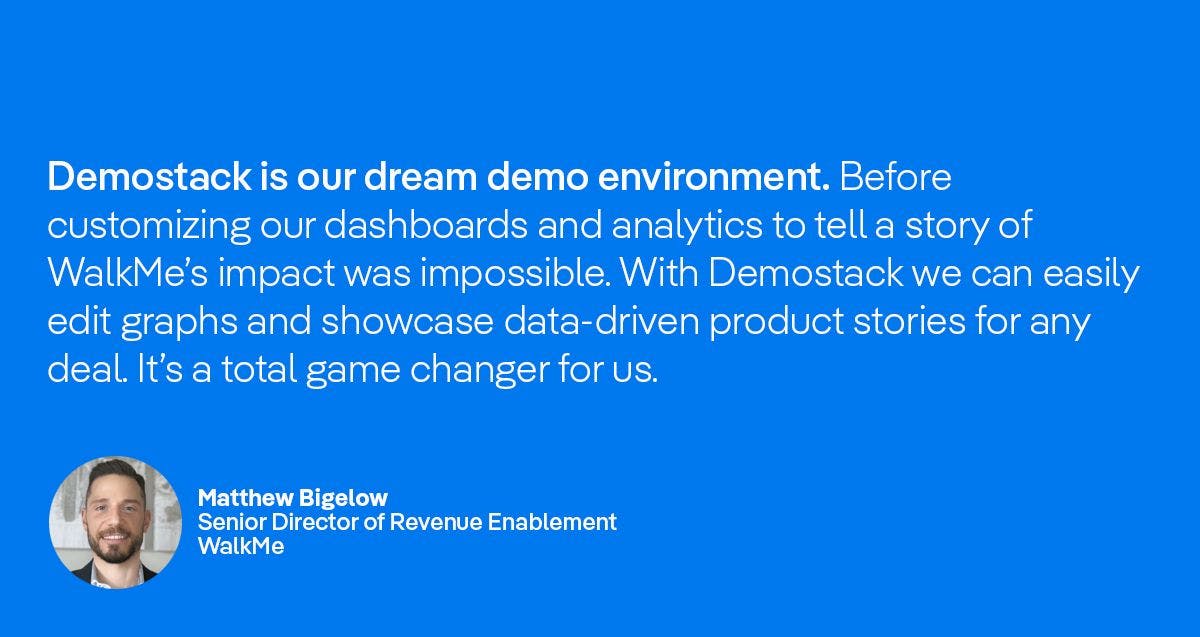The rise of product demo platforms now have revenue teams asking: do we build or buy our demo environment?
When it comes to the demo environment, choices used to be limited. Some companies still demo their production instance, while more forward-thinking organizations have built an entirely separate demo environment.
Now, product demo platforms have made both these options obsolete. Compared to bulky, unreliable, and risky in-house instances, demo platforms provide a lightweight, easily managed, and highly stable solution to revenue teams.
In today’s hyper-competitive markets, the demo is your key to a winning deal. Unless your close rate is 100%, more people will see your demo than your actual product, so why show them anything less than the best possible version?
With the average demo-to-close rate hovering around 15 to 20%, little has been done to improve that number, until now.
The product demo platform now gives you a choice: Build and maintain a bulky demo environment, or buy a tool that allows you to deliver tailored, high fidelity demos at scale to improve win rates and overall revenue performance.
Replacing your demo environment with a product demo platform has significant advantages over a solution that is developed and maintained in-house, namely:
- Engineers are relieved of demo management duties, and responsibility is shifted to the revenue team.
- The demo environment is easily updated to reflect new product releases.
- Custom demos for every prospect can be made in minutes.
- Data and charts can be edited with a few clicks to craft a tailored product story
- The demo environment is highly stable, with reduced demo anxiety and increased seller confidence

Engineers focus on product, revenue teams own the demo
A demo platform places control of the demo environment firmly in the hands of your revenue team.
Your engineers can go back to building better products, while your sales team can own the revenue process end-to-end.
With engineers fully focused on the product, your development team can be more effective and use resources more efficiently. Product improvements will take less time, and your organization receives better ROI on its engineering investment.
Further, your revenue team can take ownership of the demo entirely, and will no longer depend on product or development for custom demos.
Since development resources typically focus on current engineering needs, they may take days or even weeks to deliver custom demos or even simple changes to sales. Weeks of delay is a significant loss in terms of a sales cycle, and when you cannot show products or features, buyers lose interest.
Instead maintain your momentum with a strong, well-built, and completely tailored demo created in minutes for each and every prospect. Decrease your sales cycle length and increase revenue.
Easily update the demo environment to align with new releases and features
Since a homemade demo environment is nearly always messy and difficult to maintain, it is not always updated at the same pace as your live product. Usually, updating the demo org is an afterthought, and it is likely not supported to the same extent that your customer-facing instances are.
When this happens, your sales team is essentially selling an outdated product. The UI might be different, features might be lacking, and functionality may not be the same. Why would you show prospective customers something that isn’t at its best.
If your team uses slides for demos, they will be subject to hours of tedious work as they spend time replacing screenshots and searching for new images. (As a side note, if your team is still using slide decks to demo your product, it’s probably time to move away from that.
With a product demo platform, your demo environment can be updated with a few clicks and will instantly reflect all the awesome updates your team made. Moreso, it will be completely stable and risk-free.
Custom demos take minutes, not weeks
In a Google survey, 90% of marketers stated that personalization has significantly contributed to profitability.
Today, companies must do everything they can to be competitive. Creating a personalized demo for every opportunity is one way to stand out amongst the crowd. The “ACME'' demo is no longer effective. Generic companies, customers, and data no longer connect with prospects, and buyers glaze over when they see Tesla, Bill Gates, or SpaceX appear on your screen.
Instead, wow them with their own company’s name and logo, show them their own customers and use pertinent data in your demos.
Unfortunately, demos built in-house are extremely difficult to personalize. Likely, you only have a few demo instances that are generalized to apply to as many different organizations as possible.
Personalized demos help your buyers understand your value faster, as they can picture their own specific use case. But, with an in-house demo, your engineering teams may spend hours, or even days building a custom demo. This creates a drag on resources and turns every demo into an expensive endeavor that involves a significant investment of time and resources.
Alternatively, a product demo platform allows for the creation of customized demos in minutes. Numbers, names, charts, and images can be changed in a few clicks, and entire environments can be duplicated or edited in seconds. Little to no resources are used and your revenue team can create personalized demos for each and every sales conversation.
Update dates, times, and variables with just a few clicks
Creating a custom demo in-house requires significant resources upfront - and significant maintenance.
Days, dates, times, quarters, charts, graphs, and numbers all become outdated. This breaks the reality for your prospects and they have trouble seeing the value in something that they perceive as old and useless.

Unless your in-house demo is receiving fresh dummy data 24/7, then the environment is simply outdated. Any real-time chart or graph will fall flat and fail to convey the true power of your solution.
With outdated data, your product can be difficult to relate to. Instead, a demo platform’s ease of edibility allows your team to update data in a few clicks to ensure they always show the most relevant information for every prospect - no technical skills required.
Deliver flawless, stable demos
“Oh that’s weird, it seems like there might be something wrong, it’s not usually like this.”
If your salesperson says this, consider your deal dead. An in-house demo is constantly being worked on, and as mentioned before, might not always be updated. This puts it at high risk for failure, errors, snags, or bugs.
Moreso, at any moment another seller could be in the same environment, changing data, and leaving a nasty surprise for the next user.
This can happen at any time, to any rep, on any demo, and it’s not a good look.
All of this contributes to major demo anxiety for your reps. They need to know that their demo will work exactly as needed, at any time.
With a product demo platform, your demo environment is independent of your actual product, and not subject to any issues that may arise. Further, the demo captures the best-case scenario, ensuring that there will be zero issues during any demo.
This stability and ease of use also eliminates demo anxiety and gives sellers the confidence to enter any scenario knowing that they will have a winning demo.
When it comes to the build vs. buy question, there is no longer a single option, but there is still a single answer. For the ultimate stability, reliability, ROI, and sales effectiveness, a product demo platform provides far greater benefits than one created and managed internally.

